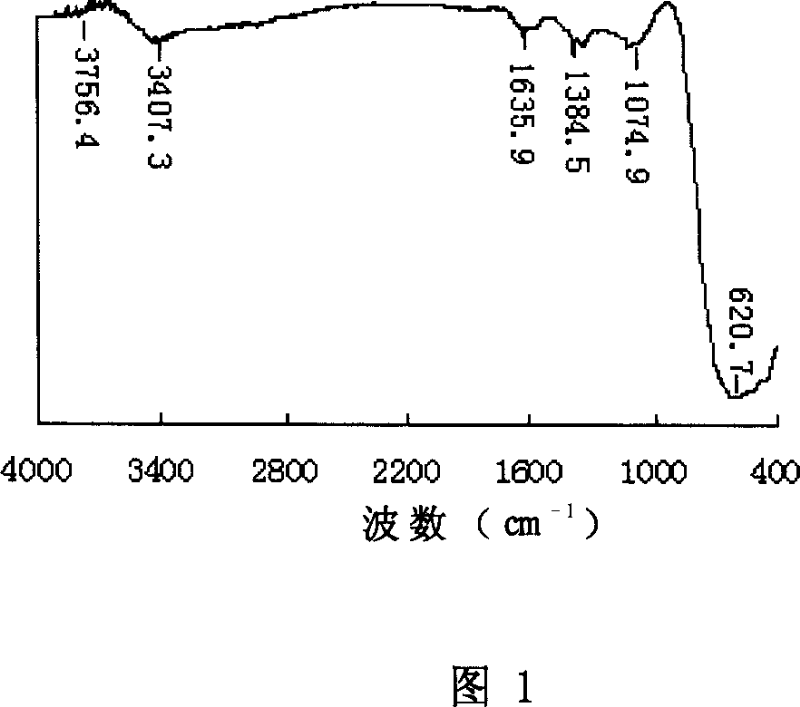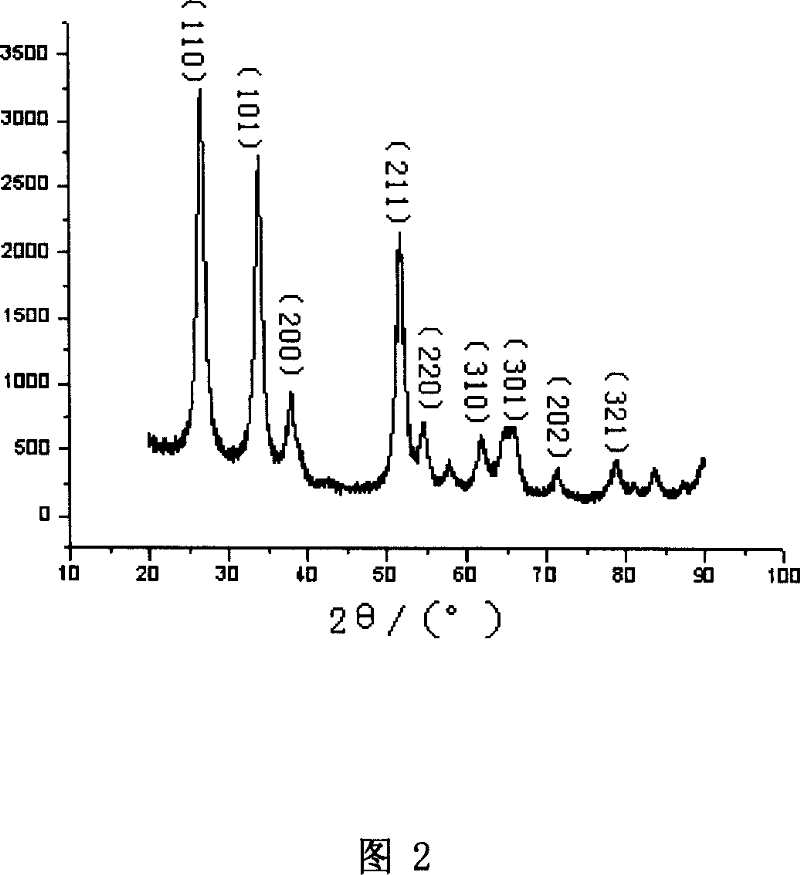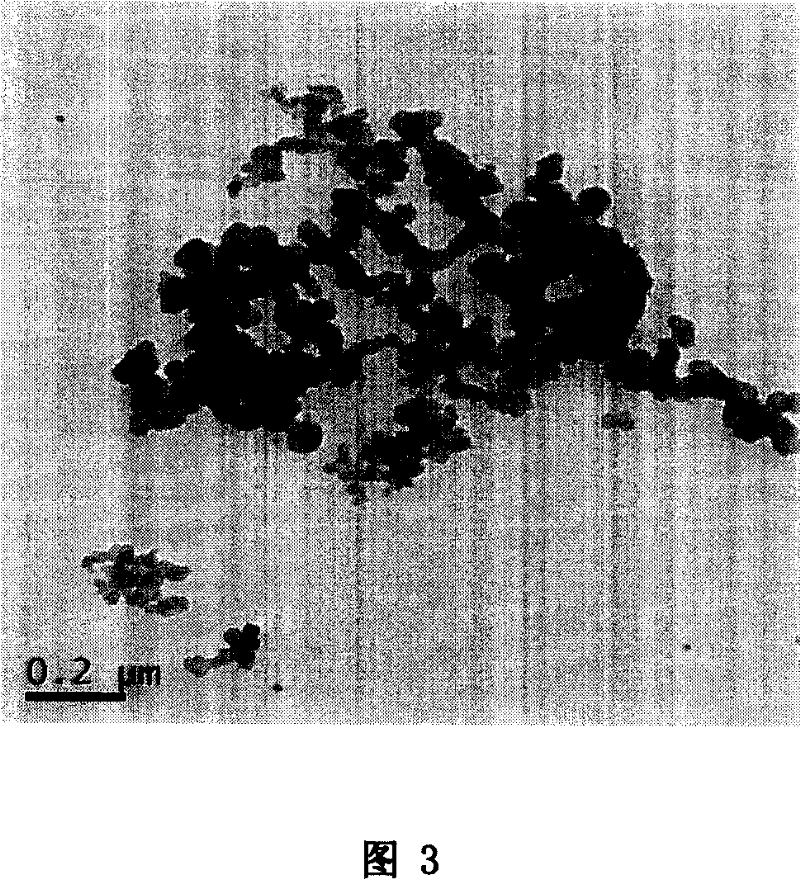Preparation process of antimony doped stannum oxide nano-crystal
An antimony-doped tin oxide and nanocrystal technology, applied in tin oxide, nanostructure manufacturing, nanotechnology and other directions, can solve the problems of long time, poor labor protection, complex synthesis process, etc., and achieve easy products, energy saving, high purity effect
- Summary
- Abstract
- Description
- Claims
- Application Information
AI Technical Summary
Problems solved by technology
Method used
Image
Examples
Embodiment 1
[0027] Dissolve 1.15g of antimony trichloride in 50ml of deionized water containing 0.75g of tartaric acid to make a clear solution, mix the clear solution with 80ml of tin nitrate aqueous solution with a concentration of 1.5mol / L, and adjust the pH of the liquid with nitric acid to 1.2. Add 12.5g multi-stage combined fuel to the tin-antimony mixture. The selection of each component in the multi-stage combined fuel follows the temperature requirements of each reaction process in the reaction process of antimony-doped tin dioxide. The components in the multi-stage combined fuel The gradation ratio of the antimony-doped tin dioxide follows the enthalpy requirements of each reaction process in the reaction process of antimony-doped tin dioxide. In this embodiment, the fuel and its ratio are selected according to different decomposition temperatures, and hydrogen carbonate with a decomposition temperature of 80-100 ° C is used. Ammonium, urea with a decomposition temperature of 140...
Embodiment 2
[0032] Mix 20ml of an aqueous solution of antimony citrate with a concentration of 0.15mol / L and 80ml of an aqueous solution of tin nitrate with a concentration of 1.5mol / L, adjust the pH value of the liquid to 1.2 with nitric acid, and add 12.5g of multi-stage combined fuel to the mixed solution of tin and antimony Composition of ammonium bicarbonate with a decomposition temperature of 80-100°C, carbazide with a decomposition temperature of 140-190°C, ammonium sulfate with a decomposition temperature of 210-380°C and ammonium perchlorate with a decomposition temperature of 400-600°C High-speed combined fuel, after high-speed mechanical stirring, it becomes a viscous paste liquid, put the porcelain dish containing the paste mixture liquid into a muffle furnace preheated to 800°C, collect and burn after the combustion process (about 20s) is over The product, 13.7g flocculent light blue ATO powder (theoretical value is 18.2g) can be obtained without grinding. The concentration i...
Embodiment 3
[0034] Dissolve 1.15g of antimony trichloride in 50ml of deionized water containing 0.75g of tartaric acid to make a clear solution, mix the clear solution with 80ml of tin tetrachloride aqueous solution with a concentration of 1.5mol / L, adjust the liquid concentration with nitric acid The pH value is 1.2; add 14.5g multi-stage combined fuel to the tin-antimony mixture, select the fuel and its ratio according to different decomposition temperatures, use ammonium bicarbonate with a decomposition temperature of 80-100°C, and a decomposition temperature of 140-190°C urea, ammonium sulfate with a decomposition temperature of 210-380°C and ammonium perchlorate with a decomposition temperature of 400-600°C to form a multi-stage combined fuel, wherein the mass ratio of each component is 5:3:1:1 , after high-speed mechanical stirring, it becomes a viscous paste liquid; put the porcelain dish containing the paste mixture liquid into a muffle furnace heated to 700°C in advance, and colle...
PUM
| Property | Measurement | Unit |
|---|---|---|
| electrical resistivity | aaaaa | aaaaa |
| particle diameter | aaaaa | aaaaa |
| electrical resistivity | aaaaa | aaaaa |
Abstract
Description
Claims
Application Information
 Login to View More
Login to View More - R&D
- Intellectual Property
- Life Sciences
- Materials
- Tech Scout
- Unparalleled Data Quality
- Higher Quality Content
- 60% Fewer Hallucinations
Browse by: Latest US Patents, China's latest patents, Technical Efficacy Thesaurus, Application Domain, Technology Topic, Popular Technical Reports.
© 2025 PatSnap. All rights reserved.Legal|Privacy policy|Modern Slavery Act Transparency Statement|Sitemap|About US| Contact US: help@patsnap.com



